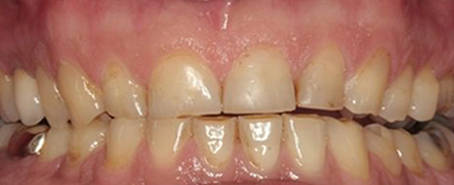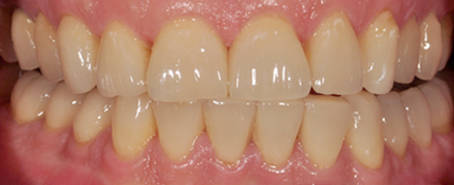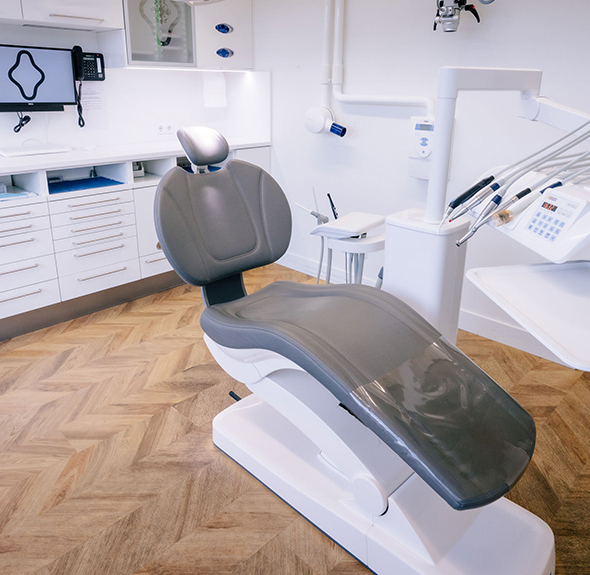Tandarts Jan van Galen
Veneers in Amsterdam
Veneers improve the appearance of your teeth. Veneer placing is the ideal way to make your teeth whiter, repair chipped or cracked teeth and fill gaps between your teeth. We craft composite or porcelain veneers in order to modify the colour and shape of your teeth as well. We place veneers as a kind of shell over your current teeth.
My tooth had broken off when I fell off my bike. My dentist recommended that I have a veneer placed. This shell over my teeth is impossible to tell apart from the real thing!
The results of veneers: before and after pictures
I didn’t mind having a few consultations before my veneers were placed. This way, I know that they are exactly the way I wanted them.
What are veneers?
Veneers are composite or porcelain shells that we can fix in place over one or more teeth. This layer of tooth-coloured material allows us to modify the shape or colour of your tooth. We use veneers mostly to repair chipped or cracked teeth, fill gaps between teeth, fix corners and camouflage crooked teeth. We place two types of veneers: composite veneers and porcelain veneers.
Advantages and disadvantages of composite veneers
Advantages of composite veneers:
Disadvantages of composite veneers:
Advantages and disadvantages of porcelain veneers
Advantages of porcelain veneers:
Disadvantages of porcelain veneers:
Veneer costs
The cost of placing veneers can vary widely. The price for treatment depends on:
In order to give you an idea of the costs, see the prices per veneer below:
| Treatment | Price |
|---|---|
| Composite veneer | € 100,- tot € 150,- per tooth |
| Porcelain veneer | € 700,- tot € 900,- per tooth |
Placing a composite veneer
We always place composite veneers immediately during a consultation. In this way you only need one consultation.
Step 1: Choosing the colour
At the first appointment, we examine your mouth and discuss your wishes. We use this information to draw up a treatment plan and prepare an estimate. You also decide which colour suits your teeth better, in conjunction with your dentist. Then we make an appointment to place your veneers.
Step 2: Making the tooth rough
At the second appointment, the specialist prepares your teeth for good composite bonding. The advantage of composite veneers is that the tooth is maintained. We will not file down your tooth any more than this.
Step 3: Affixing the veneer
In order to allow the veneer to bond properly, we apply an adhesive layer. As soon as the adhesive layer has set, we apply the composite layer by layer. Because we build up a composite veneer in layers, we can adjust it to suit your teeth perfectly.
Step 4: Shaping the tooth
The dentist applies the composite layer by layer and models it into shape. Each layer is briefly allowed to set. After that, the dentist files the veneer into the desired shape and polishes the surface. After treatment you can eat and drink anything immediately, but be careful with hot drinks until the anaesthesia has worn off.
Placing a porcelain veneer
Placing a porcelain veneer
Porcelain veneers are made in a dental laboratory, so we cannot place this type of veneer immediately. This is why several appointments are needed.
Step 1: Setting up a treatment plan
At the first appointment, we examine your mouth and discuss your wishes. We use this information to draw up a treatment plan with a corresponding estimate. You decide on the right colour for the veneer in conjunction with your dentist using a colour guide.
Step 2: Preparing the tooth
During the second appointment, the dentist prepares the teeth on which veneers will be placed. Porcelain veneers must always be half a millimetre thick and therefore it is necessary to file down your teeth in a minimally invasive way. After your teeth have been prepared, temporary veneers will be fitted so that the prepared teeth are not exposed.
Step 3: Making the veneer
We then take a plaster impression of your teeth during the consultation. We send the impression to the laboratory where the dental technician crafts the veneer in the right shape and colour. When the veneer is ready, the laboratory sends it to us so that we can fix it in place at the subsequent appointment, two to three weeks later.
Step 4: Placing the veneer
Before placing the veneer, we remove the temporary veneer. Then we treat your tooth with a dental etchant so that it will become rough. Next, we apply an adhesive layer to your tooth. We affix the veneer to it immediately and allow the adhesive layer to set. You may eat and drink anything immediately after treatment. In this way you can start to enjoy your new teeth immediately.
Frequently asked questions about veneers
How low does a veneer last?
Unfortunately, veneers do not last a lifetime. Composite veneers will have to be replaced after about five years. A porcelain veneer lasts for about 25 years. Of course, this depends on your oral hygiene and what you do with it. If you grind your teeth or bite your nails, the veneers will have to be replaced sooner.
What does it feel like to have a veneer?
A veneer feels just the same as your own tooth, but you will need some time to get used to it. If we have used veneers to make your teeth slightly longer, talking will be rather awkward at first. It may also feel odd if we have changed the shape of your teeth. This sensation will be over in about a week.
Does a veneer require special maintenance?
A veneer does not require any more maintenance than the maintenance your own teeth require. It is important that you keep your veneers clean, just as the rest of your teeth. We advise you to brush with a soft toothbrush. In this way it will be easy to remove any debris. It is also important to clean your teeth with toothpicks, interdental brushes or floss every day and to come for a periodic check-up every six months.
Can I eat anything if I have a veneer?
In principle, you can eat anything if you have a veneer. Do remember not to bite anything hard with the veneer itself, such as acid drops, your nails or a pen. We also discourage ripping adhesive tape with your teeth.
Our practice in Amsterdam West
Our dental practice at Jan van Galenstraat 171 in Amsterdam West is easily accessible by public transport from Amsterdam Central (tram 13 and bus 18), Sloterdijk station (tram 12 and bus 15), and Amsterdam Zuid station (bus 15).
Parking is available on or around Jan van Galenstraat. The parking costs are €4.50 per hour.
Make an appointment
If you would like to make a dental appointment for veneer placement, call 020 618 0074 and we will be pleased to schedule an appointment for you at short notice.



